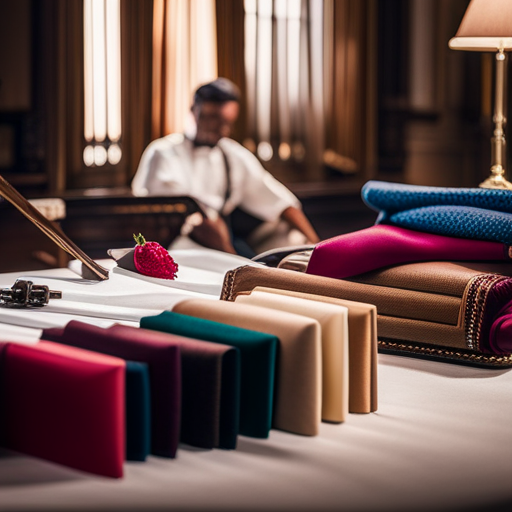Exploring Different Fabrics for Costume Design

In the vibrant world of costume design, fabric selection is an art form that shapes the very essence of a character. From the soft caress of natural fibers to the futuristic allure of synthetic fabrics, each material holds the potential to breathe life into a costume.
This article delves into the intricate tapestry of different fabrics, offering insights into their unique characteristics and the creative possibilities they present for adding depth and dimension to costume design.
Natural Fibers
Natural fibers are derived from natural sources such as plants, animals, and minerals, and are often favored for their breathability and sustainability in costume design. These fibers, such as cotton blends and silk alternatives, offer a range of benefits that make them desirable for costume designers.
Cotton blends, for example, are a popular choice due to their versatility, durability, and affordability. They are known for their comfort, moisture-wicking properties, and ease of dyeing, making them suitable for a wide range of costumes. Additionally, cotton blends are often combined with other natural or synthetic fibers to enhance their performance characteristics, further expanding their potential applications in costume design.
Silk alternatives, on the other hand, provide a cruelty-free option for costume designers who want the luxurious look and feel of silk without using traditional silk fabrics. These alternatives, which can be made from materials such as soy silk, bamboo silk, or Tencel, offer similar luster and drape as silk while being more sustainable and eco-friendly.
As costume design continues to embrace sustainability and innovation, natural fibers like cotton blends and silk alternatives are becoming increasingly important in creating costumes that are not only visually stunning but also environmentally conscious.
Synthetic Fabrics
Let’s shift our focus to synthetic fabrics, which offer a range of advantages in costume design.
These fabrics are known for their durability and ability to withstand frequent use and washing, making them ideal for theatrical productions and costume events.
Additionally, their cost-effectiveness allows for the creation of intricate and visually striking costumes without exceeding budget constraints.
Advantages of Synthetic Fabrics
Synthetic fabrics offer a wide range of advantages for costume design, including affordability, durability, and versatility. With modern advancements, these fabrics exhibit resilience and versatility, making them suitable for a variety of costume designs.
Here are some emotional responses synthetic fabrics evoke:
-
Freedom: Synthetic fabrics provide the freedom to experiment with bold and imaginative costume designs, allowing designers to unleash their creativity without constraints.
-
Confidence: The durability of synthetic fabrics instills confidence in performers, ensuring that the costumes will withstand rigorous performances without losing their visual appeal.
-
Adaptability: The versatility of synthetic fabrics allows for the creation of costumes that can adapt to different environments and movements, enhancing the overall visual impact of the performance.
This adaptability and resilience seamlessly transition into the subsequent section about durability and cost-effectiveness.
Durability and Cost-Effectiveness
The durability and cost-effectiveness of synthetic fabrics make them an appealing choice for costume designers seeking long-lasting and budget-friendly materials.
Synthetic fabrics are engineered to withstand wear and tear, making them highly durable for costume use. They are resistant to wrinkles, shrinking, and stretching, ensuring that the costumes maintain their shape and appearance over time.
Additionally, synthetic fabrics are often more affordable than natural materials, allowing costume designers to create high-quality costumes within budget constraints. This cost-effectiveness is particularly advantageous for large-scale productions or when creating multiple costumes.
Blended Materials
Blended materials offer a unique balance of durability and breathability, making them an attractive choice for costume design.
Additionally, the combination of different fabrics creates a textured and visually appealing surface, adding depth to the overall look.
It’s also important to consider how blended materials perform in various climates, as this can greatly impact the comfort and practicality of the costume.
Durability Vs. Breathability
When considering costume fabrics, it is important to evaluate the trade-off between durability and breathability, particularly in the context of blended materials. Blended fabrics offer a balanced combination of qualities, making them a popular choice for costume design.
Here are a few key points to consider when exploring the durability vs. breathability aspect of blended materials:
-
Long-lasting performance: Blended materials often provide enhanced durability, ensuring costumes can withstand the rigors of performances without sacrificing comfort.
-
Comfort: The breathability of blended fabrics contributes to the overall comfort of costumes, allowing performers to move with ease and maintain a sense of well-being throughout their routines.
-
Versatility: Blended materials offer a versatile solution, providing the necessary durability for long-term use while allowing for adequate breathability, catering to the diverse needs of costume design.
Texture and Visual Appeal
In costume design, the texture and visual appeal of blended materials play a crucial role in enhancing the overall durability and breathability of the costumes. Texture and color are essential elements that contribute to the visual impact and storytelling within the costume design.
Blended materials offer the opportunity to create a wide range of textures, from smooth and sleek to rough and coarse, adding depth and dimension to costumes. The interplay of different textures and colors can convey the character’s personality and emotional journey, enriching the visual storytelling of the performance.
By carefully selecting and blending materials, costume designers can enhance the overall visual appeal and create costumes that not only look visually stunning but also effectively communicate the narrative of the production. This attention to detail in texture and visual appeal contributes significantly to the overall impact of the costumes.
Transitioning into the subsequent section about ‘performance in various climates’, the choice of blended materials also influences the adaptability of costumes in different environmental conditions.
Performance in Various Climates
Costume designers prioritize the selection of blended materials for their ability to enhance the durability and breathability of costumes, ensuring optimal performance in various climates.
Blended materials offer advanced moisture management, wicking away sweat to keep performers dry and comfortable. They also provide effective heat retention, ensuring warmth in cold climates without sacrificing breathability.
Additionally, these materials offer enhanced flexibility, allowing performers to move with ease and grace, regardless of the climate. The incorporation of blended materials into costume design not only ensures the comfort and well-being of performers but also elevates the overall performance by enabling them to fully embody their characters.
This focus on functionality in various climates seamlessly transitions into the subsequent section about ‘luxurious textiles’, where the emphasis shifts to aesthetics and elegance.
Luxurious Textiles
Luxurious textiles play a pivotal role in elevating the aesthetic and quality of costume designs, imparting a sense of opulence and sophistication to the overall look.
Among the most esteemed fabrics for creating luxurious costumes are silk satin and velvet. Silk satin, with its smooth and lustrous surface, adds an element of elegance and refinement to costumes. Its ability to drape beautifully makes it a popular choice for creating flowing and form-fitting garments that exude luxury.
On the other hand, velvet, with its soft pile and rich texture, is synonymous with luxury and is often used for creating opulent and regal costumes. Its unique ability to reflect light gives costumes a lavish and sumptuous appearance. Additionally, velvet draping adds depth and dimension to costume designs, making them visually captivating.
When working with luxurious textiles like silk satin and velvet, costume designers can create garments that not only look exquisite but also convey the essence and grandeur of the characters they adorn.
Functional Workhorses
Amidst the opulence of luxurious textiles, costume designers frequently rely on functional workhorse fabrics to ensure durability and practicality in their designs. These performance fabrics are essential in costume construction, providing the necessary support for the wear and tear that costumes endure during performances and productions. They not only contribute to the visual aesthetics but also play a crucial role in the overall functionality of the costumes.
-
Durability: Functional workhorse fabrics are designed to withstand rigorous use, ensuring that costumes maintain their integrity throughout multiple performances.
-
Flexibility: These fabrics allow for ease of movement, essential for performers to execute their routines without constraints.
-
Breathability: Comfort is key, and performance fabrics provide breathability, keeping performers cool and comfortable under hot stage lights and during physically demanding scenes.
In the realm of costume design, the incorporation of functional workhorse fabrics is indispensable, as they form the backbone of costume construction, ensuring that the costumes not only look stunning but also withstand the demands of stage performances.
Specialty and Novelty Fabrics
Incorporating specialty and novelty fabrics introduces an element of creativity and innovation into costume construction, enhancing the visual impact and aesthetic appeal of the designs.
Unique textures and innovative designs offered by specialty and novelty fabrics provide costume designers with a wide array of artistic expression and creative possibilities.
These fabrics can range from holographic materials and metallic textiles to 3D-printed fabrics and LED-embedded textiles.
The use of these unconventional materials allows for the creation of costumes that are truly one-of-a-kind, pushing the boundaries of traditional costume design.
Designers can play with unconventional patterns, textures, and finishes, adding depth and dimension to their creations.
These fabrics also offer the opportunity to incorporate technology, such as light-up elements or interactive features, into the costumes, further elevating the overall impact.
Sustainable and Eco-Friendly Options
The incorporation of sustainable and eco-friendly fabric options into costume design allows for a conscientious approach to material selection, aligning with contemporary environmental concerns and promoting responsible resource utilization. Designers are increasingly turning to sustainable options to reduce the environmental impact of costume production.
This shift towards sustainability encompasses various approaches, including:
-
Upcycled textiles, ethical production: Utilizing upcycled textiles not only reduces waste but also adds a unique and vintage flair to costume design. Ethical production practices ensure that the creation of these fabrics aligns with fair labor standards, contributing to a more socially responsible industry.
-
Biodegradable fibers, sustainable sourcing: Embracing biodegradable fibers such as organic cotton, hemp, and bamboo allows for the creation of costumes that can naturally decompose at the end of their lifecycle, minimizing environmental harm. Additionally, sourcing materials from sustainable suppliers who prioritize eco-friendly practices further enhances the overall environmental impact of costume design.
Frequently Asked Questions
Where Can I Purchase the Different Fabrics Mentioned in the Article?
When searching for specific fabrics mentioned in the article, consider various purchasing options. Local fabric stores, online retailers, and wholesale fabric suppliers are viable choices. Research each option to find the best quality and price.
Are There Any Specific Care Instructions for Maintaining the Quality of These Fabrics?
Care instructions are essential for maintaining fabric durability. Maintenance tips, including proper washing techniques, can help preserve the quality of different fabrics. It’s important to follow specific care instructions to ensure long-lasting and well-maintained fabrics.
What Are the Typical Costs Associated With Each Type of Fabric?
Cost considerations for different fabrics vary based on factors such as material, quality, and sourcing. Fabric durability also impacts long-term costs. It’s important to weigh initial expenses against long-term maintenance and replacement costs.
Can These Fabrics Be Dyed or Customized for Specific Costume Designs?
Custom dyeing and fabric customization are common practices for specific costume designs. It’s crucial to source fabrics that can be dyed or customized to achieve the desired look. Consider cost comparison and quality when sourcing these materials.
Are There Any Potential Allergic Reactions or Sensitivities to Consider When Using These Fabrics for Costumes?
When considering potential allergic reactions or sensitivities, it’s important to thoroughly research fabric sourcing, customization options, and maintenance tips. Cost considerations should also be factored in when selecting fabrics for costume design.
Conclusion
In conclusion, the exploration of different fabrics for costume design reveals a wide range of options available to designers. From natural fibers to sustainable and eco-friendly choices, the possibilities are endless.
For example, the use of sustainable bamboo fabric in costume design not only promotes environmental consciousness but also evokes a sense of responsibility and care for the planet, resonating with audiences on a deeper level.

Rufus Whitver is a passionate costume artisan and the creative mind behind layuo.com. With a keen eye for detail and a flair for imaginative design, Rufus brings characters to life through the art of costume making. His expertise encompasses a wide range of styles, from historical recreations to fantastical creations. Through layuo.com, Rufus shares insights, tutorials, and a portfolio showcasing his exceptional craftsmanship, inspiring fellow enthusiasts to embark on their own journey into the world of stunning costumes.





